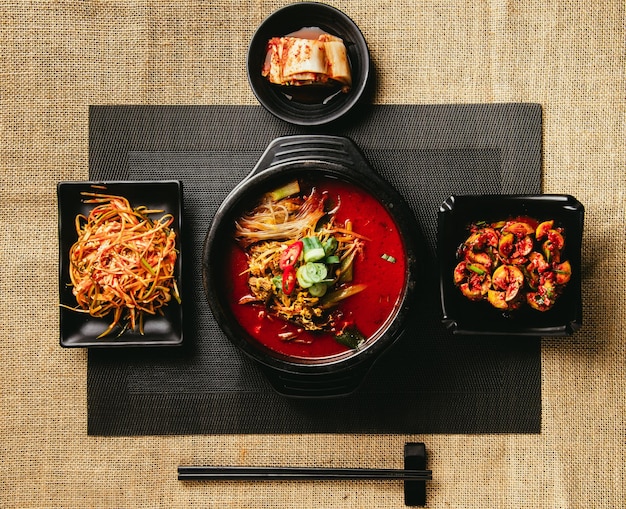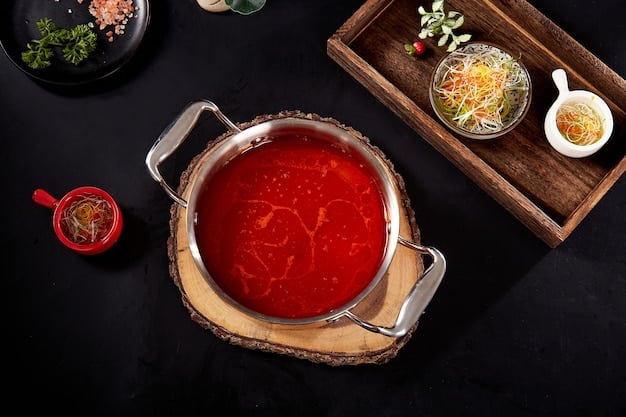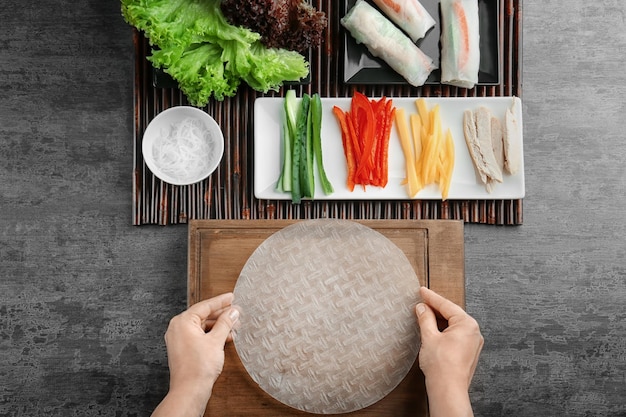K-Drama Food Trends: Recreate Dishes from Your Favorite Shows

K-Drama food trends invite viewers to recreate iconic Korean dishes seen on screen, offering a delicious way to connect with their favorite shows by exploring and mastering the culinary delights showcased in popular K-Dramas at home.
Immerse yourself in the captivating world of K-Dramas and elevate your viewing experience by recreating iconic dishes from your favorite shows. The exciting world of **K-Drama food trends** offers a unique culinary journey, allowing you to savor the flavors and aromas that have graced your screen.
Unveiling the Culinary Allure of K-Dramas
K-Dramas are renowned for their compelling storylines, captivating characters, and picturesque settings. However, beyond the on-screen drama and romance lies a vibrant culinary world that sparks curiosity and invites viewers to explore the rich tapestry of Korean cuisine. Food plays a significant role in K-Dramas, often symbolizing relationships, reflecting cultural values, and adding depth to the narrative.
From sizzling street food to elaborate royal cuisine, K-Dramas showcase a diverse range of dishes that tantalize the taste buds and leave viewers craving for more. This culinary exposure has led to the rise of K-Drama food trends, where fans around the world seek to recreate these dishes in their own kitchens, bringing a piece of their favorite shows into their daily lives.
The Rise of Mukbang and its Influence
Mukbang, a live online audiovisual broadcast in which a host eats large quantities of food while interacting with their audience, has significantly amplified the influence of food in K-Dramas. Often, K-Drama characters are depicted enjoying lavish meals, mirroring the mukbang trend and further fueling the desire for viewers to recreate these dishes.
- Enhanced Sensory Experience: Mukbang emphasizes the sounds and visuals of eating, making viewers more attuned to the sensory aspects of food portrayed in K-Dramas.
- Social Connection: Mukbang fosters a sense of community and shared enjoyment around food, which translates to viewers wanting to participate in the culinary experience themselves.
- Increased Exposure: Mukbang provides additional exposure to Korean dishes, showcasing their preparation and consumption, which then drives interest in recreating the recipes at home.
In essence, the intersection of K-Dramas and mukbang has nurtured a growing passion for Korean cuisine and a desire to experience it firsthand, further propelling the popularity of K-Drama food trends.
Popular Korean Dishes Featured in K-Dramas
Numerous Korean dishes have gained immense popularity due to their frequent appearances in K-Dramas. These dishes often become synonymous with the shows themselves, sparking a global interest in Korean gastronomy.
From comforting stews to flavorful noodles, these iconic K-Drama dishes have captured the hearts (and stomachs) of viewers worldwide, resulting in an upsurge in home cooking and restaurant cravings. Let’s explore some of the most beloved and frequently featured dishes in K-Dramas.

Tteokbokki: Spicy Rice Cakes
Tteokbokki, a beloved Korean street food, boasts a fiery kick and chewy texture. These cylindrical rice cakes are simmered in a spicy gochujang-based sauce, often accompanied by fish cakes, scallions, and boiled eggs. Its versatility allows for numerous variations, each offering a unique flavor profile influenced by regional preferences.
- Street Food Staple: Tteokbokki is widely available from street vendors throughout South Korea.
- Rich Sauce: The spicy and slightly sweet gochujang sauce is central to the dish.
- Customizable Heat: You can easily adjust to your heat preference.
Tteokbokki’s iconic status in K-Dramas has led to a global surge in demand for this spicy and satisfying snack, making it a must-try for K-Drama enthusiasts and food lovers alike.
Kimchi Jjigae: Kimchi Stew
Kimchi Jjigae, a quintessential Korean stew, embodies the essence of comfort food with its savory depth and tangy warmth. The stew features fermented kimchi as its star ingredient, along with tofu, pork belly, scallions, and a vibrant broth infused with gochujang or gochugaru (Korean chili powder).
The fermentation process lends a unique sourness to the dish, while the various ingredients intertwine to create a harmonious symphony of flavors. It’s known for its comforting nature and nutritional value, making it a popular choice during colder months.
Kimchi Jjigae’s frequent appearance in K-Dramas has cemented its place as a culinary icon, captivating viewers with its rustic charm and hearty appeal.
Japchae: Glass Noodles with Vegetables
Japchae, a vibrant and colorful noodle dish, showcases the art of balance and harmony in Korean cuisine. This dish features glass noodles made from sweet potato starch, stir-fried with an assortment of vegetables, thinly sliced meat (usually beef), and a flavorful sesame oil-based sauce.
Japchae’s versatility lies in its ability to adapt to various dietary preferences and seasonal ingredients. The combination of textures and colors makes it visually appealing, while the balanced flavors create a satisfying culinary experience. It symbolizes celebration and togetherness, making it a common dish served during special occasions and festive gatherings.
Japchae’s elegant presentation and delightful taste have made it an appealing addition to many K-Dramas, further increasing demand from viewers to try this flavorful dish.
Recreating K-Drama Dishes at Home: A Culinary Adventure
Embarking on a culinary adventure to recreate K-Drama dishes at home allows you to connect with your favorite shows on a deeper level. By engaging with the flavors, aromas, and techniques of Korean cuisine, you can forge a stronger bond with the culture and stories that have captivated you.
With readily available ingredients and user-friendly recipes, the journey of recreating K-Drama dishes is both accessible and rewarding. Follow these tips to make your culinary adventure truly special.
Sourcing Authentic Ingredients
One of the keys to successfully recreating K-Drama dishes is using authentic ingredients. While substitutions may be possible in some cases, using traditional Korean ingredients will ensure a more accurate representation of the dish’s intended flavor profile. Try to shop at your local Asian grocery store. You can find anything from gochujang to dried anchovies.
- Gochujang: A fermented red chili paste that adds a spicy and umami flavor to dishes.
- Gochugaru: Korean chili powder, used for its vibrant color and nuanced heat.
- Sesame Oil: Adds a nutty and aromatic dimension to many Korean dishes.
By sourcing authentic ingredients, you can ensure that your homemade K-Drama dishes stay true to their culinary roots.
Mastering Basic Korean Cooking Techniques
While Korean cuisine may seem intimidating at first, mastering a few basic cooking techniques can significantly enhance your culinary journey. Practice makes perfect, so consider trying a few of the classics.
From stir-frying to stewing, understanding these fundamental techniques will empower you to confidently recreate a wide range of Korean dishes. These cooking techniques are fairly easy to learn and will become second nature with practice.

Simple Steps for Your Favorite Dishes
Recreating popular Korean dishes doesn’t have to be an overwhelmingly difficult task. You can start with a simple recipe and adjust over time to further match your preferences. Below are some basic steps to get you started.
Start simple by following a recipe and gathering the core ingredients. From there, you can make tiny adjustments to suit your taste preferences. Don’t be afraid to get messy and practice.
Enhancing Your K-Drama Viewing Experience with Food
Elevate your K-Drama viewing experience by pairing your favorite shows with the iconic dishes that grace the screen. This sensory immersion will transport you into the heart of the story, allowing you to connect with the characters, settings, and cultural nuances on a deeper level.
Creating a themed menu for your K-Drama nights not only adds a layer of excitement but also fosters a sense of community and shared enjoyment among fellow viewers. Whether it’s a solo binge-watching session or a gathering with friends, savoring the flavors of K-Drama cuisine enhances the overall experience.
Creating a Themed K-Drama Menu
Crafting a themed K-Drama menu is an art form that allows you to showcase your creativity and appreciation for Korean cuisine. Consider the dishes that are prominently featured in the show and build your menu around them.
For a romantic comedy, opt for light and refreshing dishes that reflect the playful and heartwarming nature of the story. For a historical drama, delve into the rich culinary heritage of the Joseon Dynasty and prepare dishes that were fit for royalty. No matter the genre, a themed menu adds more immersion to your K-Drama experience.
Setting the Ambiance
Transform your home into a cozy Korean dining experience by incorporating traditional elements into your table setting. Use Korean dinnerware, such as bowls and chopsticks, to create an authentic atmosphere. Light some candles and play some soft Korean music to set the mood.
- Traditional Dinner Ware: A set of uniquely designed bowls and chopsticks.
- Subtle Lighting: Soft lighting can make the experience more calm and relaxing.
- Soft Music: Subtly incorporate a favorite Korean song in the background.
Setting the ambiance enhances the immersion in the viewing experience and amplifies the sensory pleasure of your culinary journey.
The Future of K-Drama Food Trends
As K-Dramas continue to captivate audiences worldwide, the popularity of K-Drama food trends is expected to grow exponentially. With new shows constantly emerging and showcasing a diverse range of dishes, the culinary landscape of K-Dramas will continue to evolve and inspire home cooks around the world.
Technological advancements, such as augmented reality and virtual reality, may further enhance the K-Drama viewing experience by allowing viewers to virtually “taste” the dishes featured on screen. The intersection of food, entertainment, and technology will undoubtedly pave the way for exciting new possibilities in the world of K-Drama food trends.
In conclusion, the fusion of food and entertainment is set to elevate K-Drama viewing to unparalleled heights, blurring the lines between on-screen drama and real-life culinary delight.
| Key Point | Brief Description |
|---|---|
| 🍜 Iconic Dishes | Explore dishes like Tteokbokki, Kimchi Jjigae, and Japchae |
| 🛒 Authentic Ingredients | Source ingredients like gochujang and sesame oil for better taste. |
| 🎬 Themed Menus | Create themed menus for immersive K-Drama nights. |
| 🎶 Setting the Mood | Use Korean dinnerware and music for an authentic experience. |
Frequently Asked Questions
▼
Essential Korean ingredients include gochujang (fermented chili paste), gochugaru (Korean chili powder), soy sauce, sesame oil, rice vinegar, and doenjang (fermented soybean paste). These ingredients are fundamental to many dishes.
▼
Yes, but with caution. Soy sauce can substitute for some of fish sauce. For gochujang, you can use a mix of miso paste and chili flakes, but it won’t perfectly replicate the flavor.
▼
“Let’s Eat” is a fantastic series that heavily features Korean cuisine. Another option is “Wok of Love,” which revolves around a Chinese-Korean restaurant, showcasing a variety of dishes.
▼
Reduce the amount of gochujang and gochugaru in recipes. For stews like Kimchi Jjigae, use older kimchi, which is less spicy than fresh kimchi. Incorporate ingredients to balance the heat.
▼
Yes, many Korean dishes can be adapted for vegetarians. Bibimbap, Japchae, and vegetable pancake variations are popular choices. Make sure to substitute meat-based ingredients with tofu or mushrooms.
Conclusion
The allure of K-Dramas extends beyond their captivating storylines; they offer a rich culinary experience that invites viewers to explore and recreate iconic dishes. By embracing K-Drama food trends, you can embark on a delicious adventure, savoring the flavors of Korea and connecting with your favorite shows on a deeper, more immersive level.





